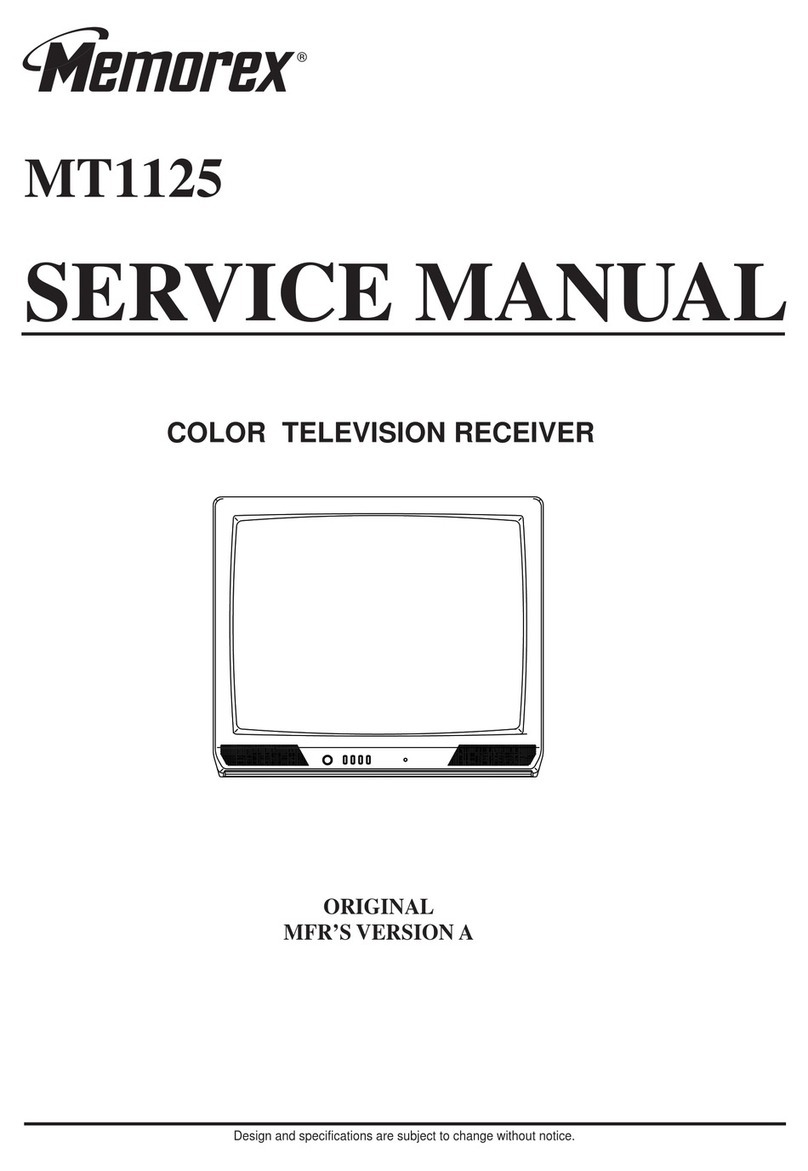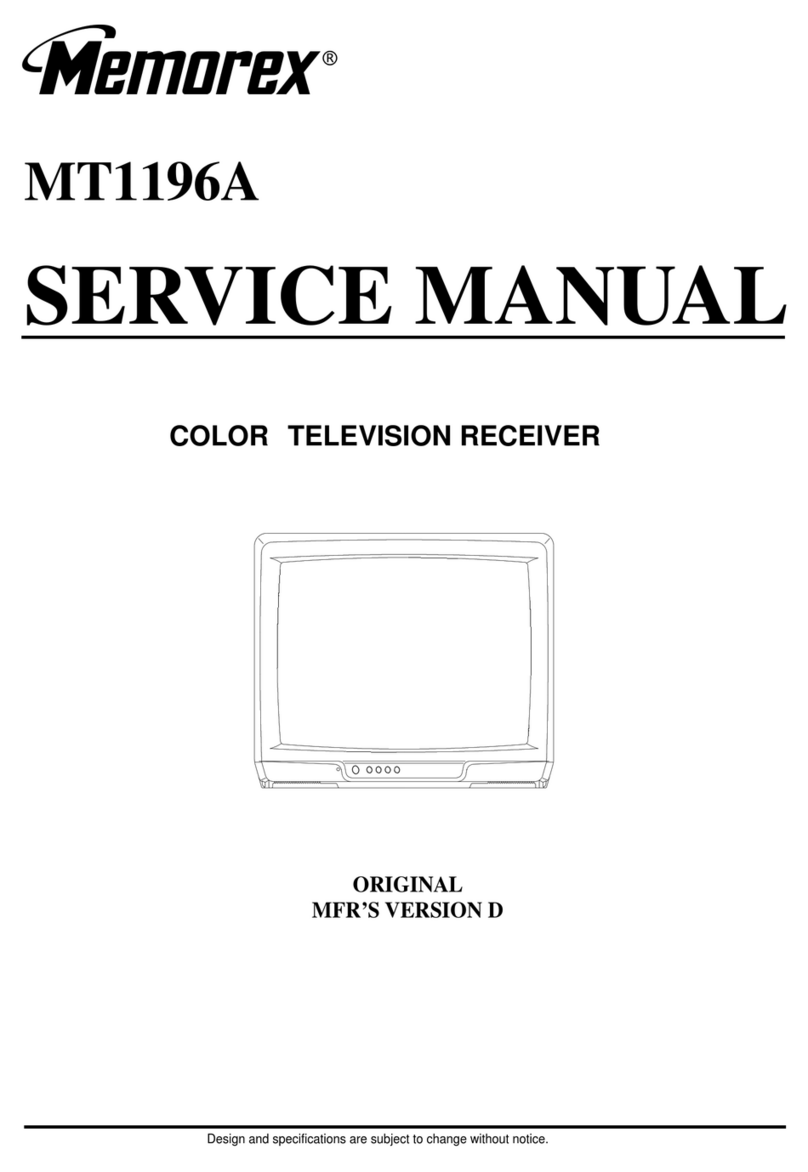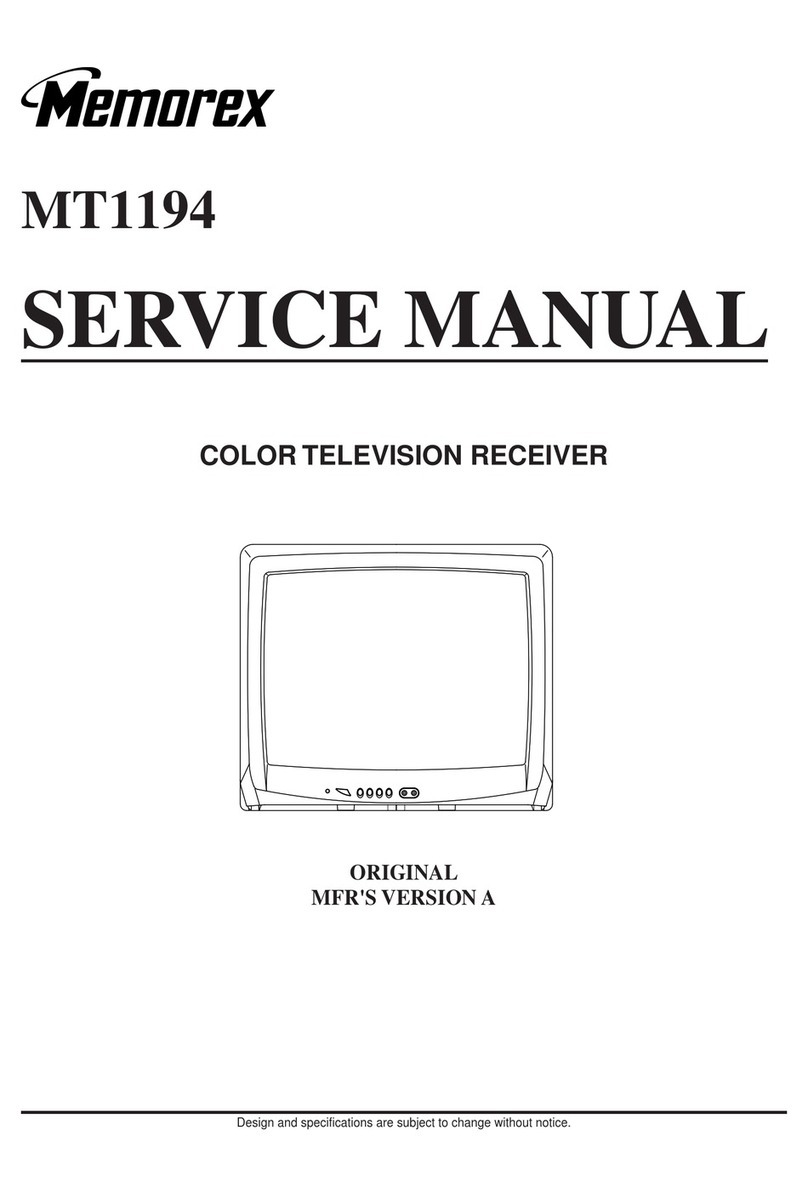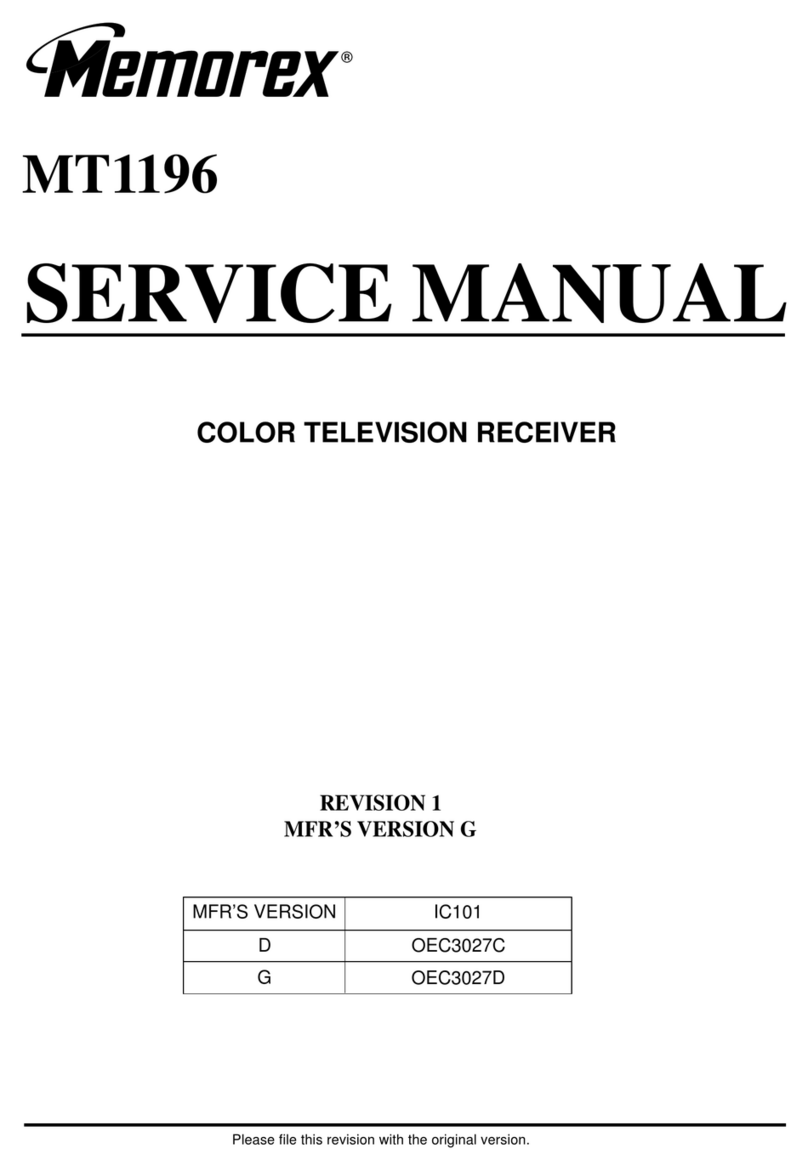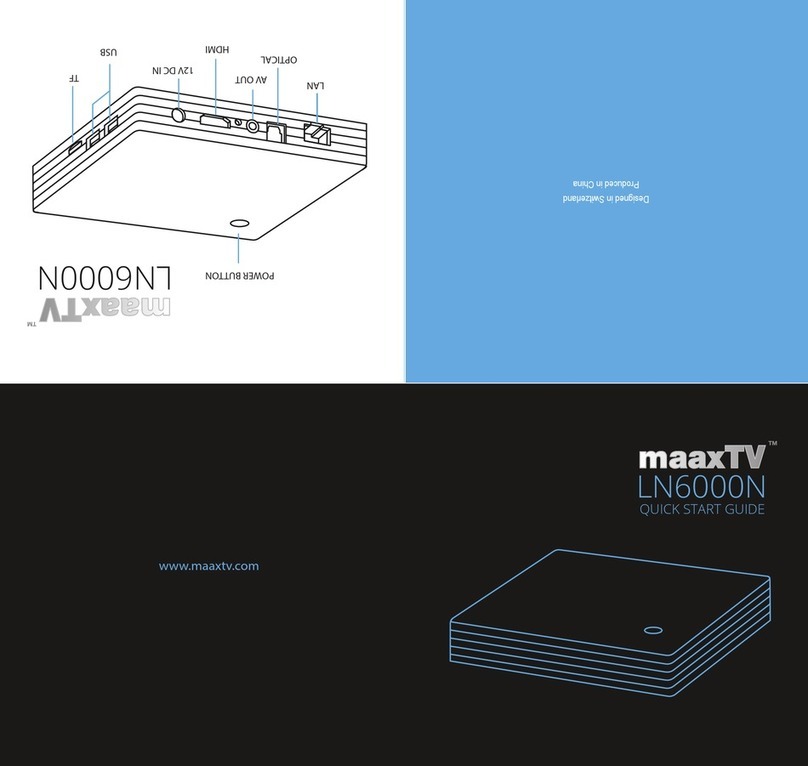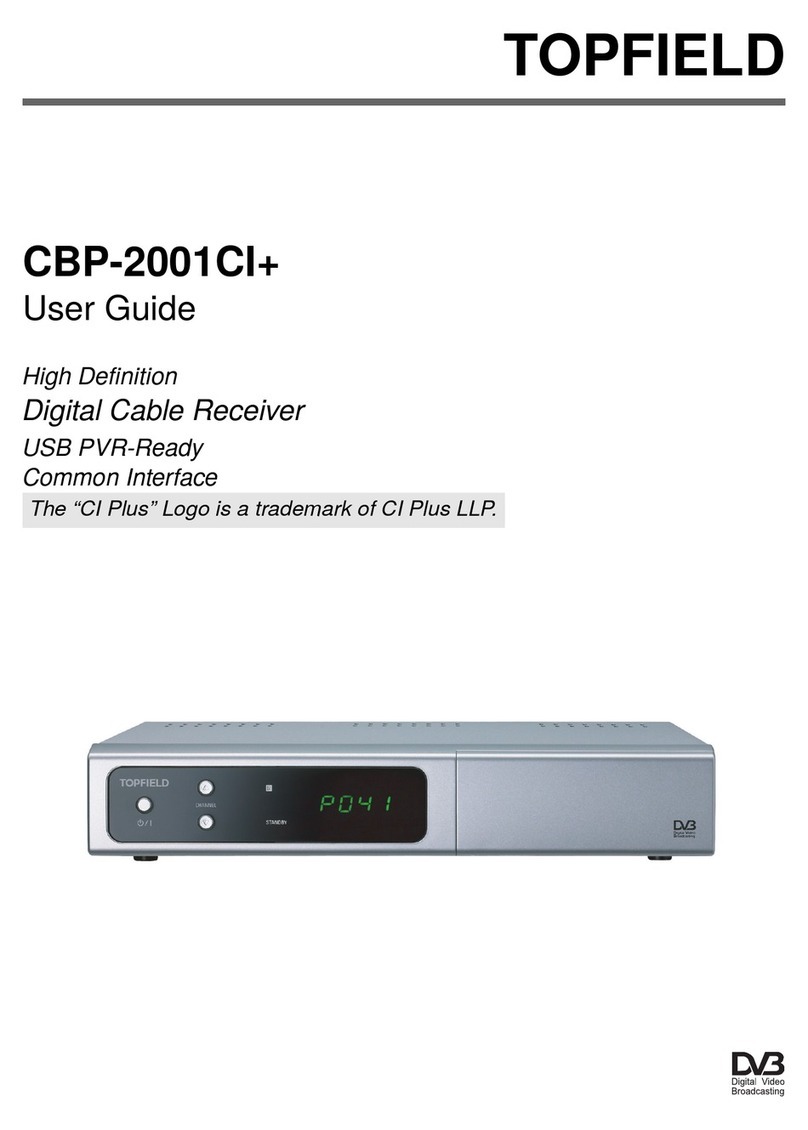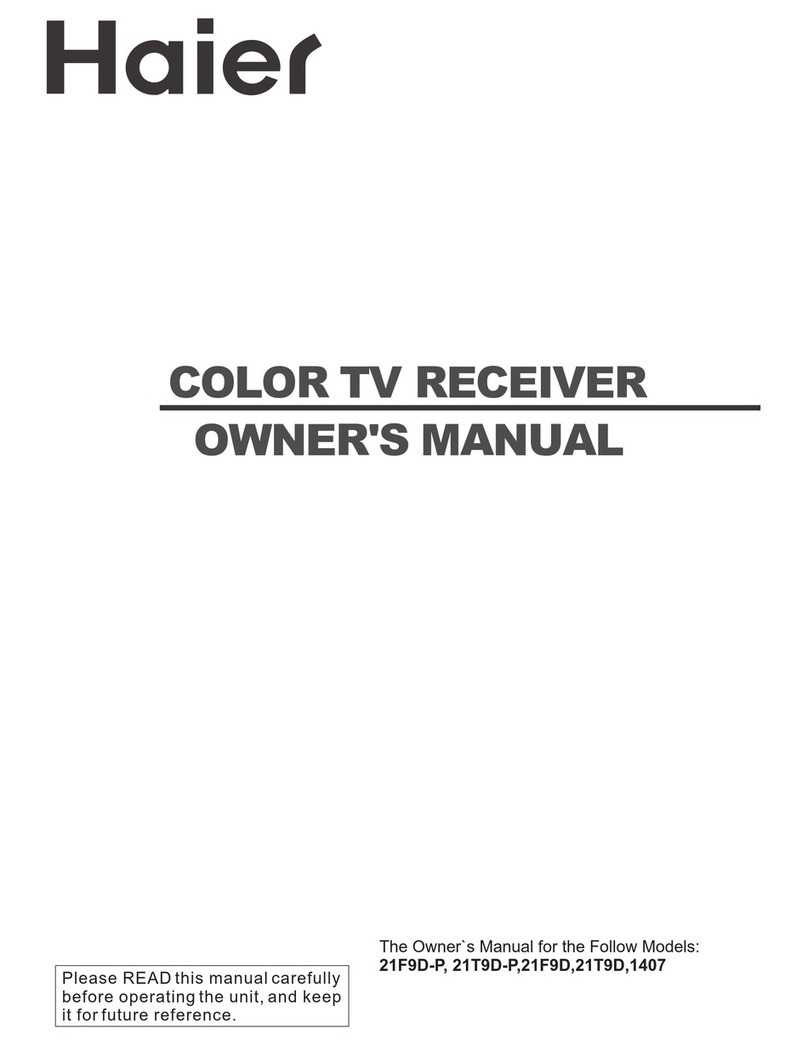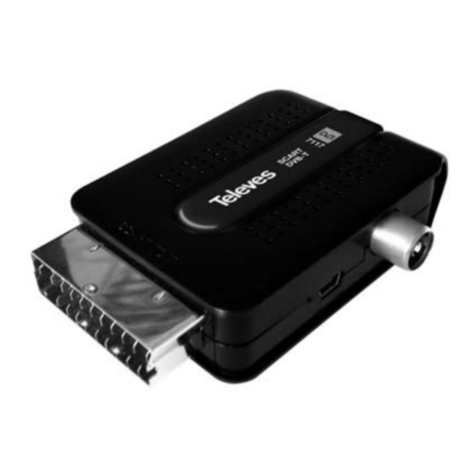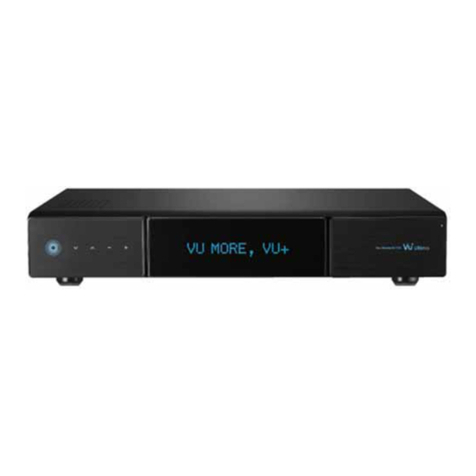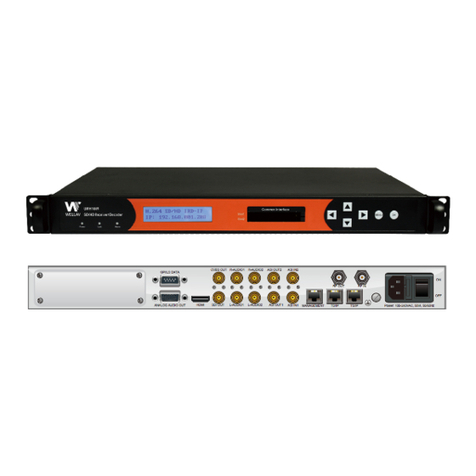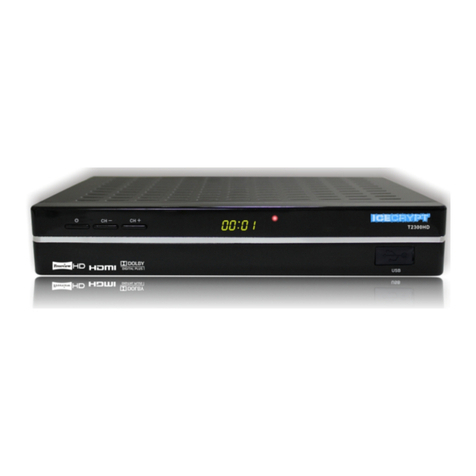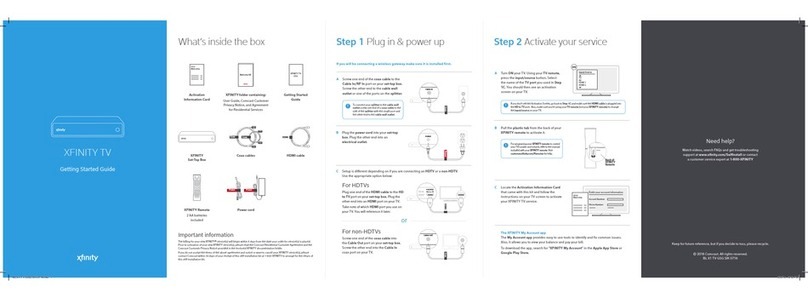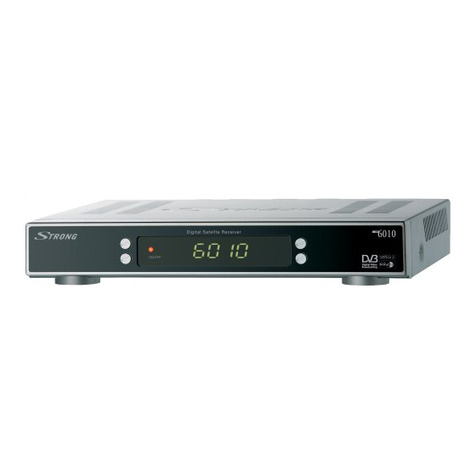Memorex MT1125A User manual

SERVICE MANUAL
Design and specifications are subject to change without notice.
MT1125A
COLOR TELEVISION RECEIVER
ORIGINAL
MFR’S VERSION B

SERVICE MANUAL
COLOR TELEVISION RECEIVER
MT1125A
G
F
MFR’S VERSION
OEC7044B
OEC7044A
IC101
REVISION 1
MFR’S VERSION G
Please file this revision with the original version.
A63AFW36X
A63AHC26X
CRT

NOTE FOR THE REPLACING OF MEMORY IC
MFR'S VERSION F MFR'S VERSION G
ADDRESS DATA DATA
03 31 30
0A F4 FF
Alteration of IC.
REF.NO PART NO. DESCRIPTION PART NO. DESCRIPTION
IC101 I56F07044A IC OEC7044A I56F07044B IC OEC7044B
PCB010 A3I055H01A MAIN PCB ASS'Y TMX458A A3I055F01A MAIN PCB ASS'Y TMX458A
MAIN PCB's are interchangeable.
Alteration of CRT.
REF.NO PART NO. DESCRIPTION PART NO. DESCRIPTION
! V801 0984250502 COLOR PICTURE TUBE A63AHC26X 092T250501 COLOR PICTURE TUBE A63AFW36X
! R429 R6558A1R8J R,FUSE 1.8 OHM 2W R6558A4R7J R,FUSE 4.7 OHM 2W
! R406 R801R7332J RC 3.3K OHM 1/10W R801R7272J RC 2.7K OHM 1/10W
PCB110 A3I055H11A CRT PCB ASS'Y TCX318A A3I055F11A CRT PCB ASS'Y TCX318A
CRT PCB's are not interchangeable.
M3I0-55F
A083528O/R NO.
MFR'S VERSION F MFR'S VERSION G
DIFFERENCES
MFR'S VERSION F MFR'S VERSION G
SPEC.NO.

SERVICE MANUAL
MT1125A
COLOR TELEVISION RECEIVER
D
B
MFR’S VERSION
OEC3041B
OEC3041A
IC101
REVISION 1
MFR’S VERSION D
Please file this revision with the original version.

DIFFERENCES
Alteration of IC.
MFR'S VERSION B MFR'S VERSION D
REF.NO PART NO. DESCRIPTION PART NO. DESCRIPTION
IC101 I53F53041A IC OEC3041A I53F53041B IC OEC3041B
PCB010 A3I011H01A MAIN PCB ASS'Y TM9441A A3I011H01B MAIN PCB ASS'Y TM9441A
MAIN PCB's are interchangeable.
M3I0-11H
A9Y3521
SPEC.NO.
O/R NO.

6. AVOID AN X-RAY1. KEEP THE NOTICES
5. TAKE CARE TO DEAL WITH THE
CATHODE-RAY TUBE
In the condition that an explosion-proof cathode-
ray tube is set in this equipment, safety is
secured against implosion. However, when
removing it or serving from backward, it is
dangerous to give a shock. Take enough care to
deal with it.
Safety is secured against an X-ray by consider-
ing about the cathode-ray tube and the high
voltage peripheral circuit, etc.
Therefore, when repairing the high voltage pe-
ripheral circuit, use the designated parts and
make sure not modify the circuit.
Repairing except indicates causes rising of high
voltage, and it emits an X-ray from the cathode-
ray tube.
Please include the following informations when you order parts. (Particularly the VERSION LETTER.)
1. MODEL NUMBER and VERSION LETTER
The MODEL NUMBER can be found on the back of each product and the VERSION LETTER can be
found at the end of the SERIAL NUMBER.
2. PART NO. and DESCRIPTION
You can find it in your SERVICE MANUAL.
Inferior silicon grease can damage IC's and transistors.
When replacing an IC's or transistors, use only specified silicon grease (YG6260M).
Remove all old silicon before applying new silicon.
IMPORTANT
HOW TO ORDER PARTS
SERVICING NOTICES ON CHECKING
As for the places which need special attentions,
they are indicated with the labels or seals on the
cabinet, chassis and parts. Make sure to keep the
indications and notices in the operation manual.
2. AVOID AN ELECTRIC SHOCK
There is a high voltage part inside. Avoid an
electric shock while the electric current is
flowing.
3. USE THE DESIGNATED PARTS
The parts in this equipment have the specific
characters of incombustibility and withstand
voltage for safety. Therefore, the part which is
replaced should be used the part which has
the same character.
Especially as to the important parts for safety
which is indicated in the circuit diagram or the
table of parts as a mark, the designated
parts must be used.
PUT PARTS AND WIRES IN THE
ORIGINAL POSITION AFTER
ASSEMBLING OR WIRING
4.
There are parts which use the insulation
material such as a tube or tape for safety, or
which are assembled in the condition that
these do not contact with the printed board.
The inside wiring is designed not to get closer
to the pyrogenic parts and high voltage parts.
Therefore, put these parts in the original
positions.
7.PERFORM A SAFETY CHECK AFTER
SERVICING
Confirm that the screws, parts and wiring which
were removed in order to service are put in the
original positions, or whether there are the
portions which are deteriorated around the
serviced places serviced or not. Check the
insulation between the antenna terminal or
external metal and the AC cord plug blades.
And be sure the safety of that.
(INSULATION CHECK PROCEDURE)
1.
2.
3.
4.
Unplug the plug from the AC outlet.
Remove the antenna terminal on TV and turn
on the TV.
Insulation resistance between the cord plug
terminals and the eternal exposure metal
[Note 2] should be more than 1M ohm by
using the 500V insulation resistance meter
[Note 1].
If the insulation resistance is less than 1M
ohm, the inspection repair should be
required.
[Note 1]
If you have not the 500V insulation
resistance meter, use a Tester.
[Note 2]
External exposure metal: Antenna terminal
A1-1

CONTENTS
SERVICING NOTICES ON CHECKING ......................................................................................................
HOW TO ORDER PARTS............................................................................................................................
IMPORTANT ...............................................................................................................................................
CONTENTS .................................................................................................................................................
GENERAL SPECIFICATIONS.....................................................................................................................
DISASSEMBLY INSTRUCTIONS................................................................................................................
SERVICE MODE LIST ................................................................................................................................
CONFIRMATION OF USING HOURS .........................................................................................................
NOTE FOR THE REPLACING OF MEMORY IC ........................................................................................
ELECTRICAL ADJUSTMENTS...................................................................................................................
MAJOR COMPONENTS LOCATION GUIDE .............................................................................................
BLOCK DIAGRAM......................................................................................................................................
PRINTED CIRCUIT BOARDS
MAIN/CRT/AV/STEREO ....................................................................................................................
SCHEMATIC DIAGRAMS
MICON/TUNER .................................................................................................................................
CHROMA ...........................................................................................................................................
DEFLECTION/CRT ............................................................................................................................
POWER .............................................................................................................................................
SOUND AMP .....................................................................................................................................
VIDEO SWITCH/IN/OUT ....................................................................................................................
STEREO ............................................................................................................................................
WAVEFORMS .............................................................................................................................................
MECHANICAL EXPLODED VIEW ..............................................................................................................
MECHANICAL REPLACEMENT PARTS LIST...........................................................................................
ELECTRICAL REPLACEMENT PARTS LIST ............................................................................................
A2-1
A1-1
A1-1
A1-1
A2-1
A3-1~A3-5
B-1, B-2
C-1
C-1
C-1
D1-1~D2-1
D3-1
E-1, E-2
F-1~F-4
G-1, G-2
G-3, G-4
G-5, G6
G-7, G-8
G-9, G-10
G-11, G-12
G-13, G-14
H-1~H-3
I-1
J1-1
J2-1, J2-2

GENERAL SPECIFICATIONS
A3-1
G-1.Outline of theProduct
25 inch( 626 mmV):Measured diagonally
Color CRT 100 degree deflection
G-2.Broadcasting System
US System M
G-3.Color System NTSC PAL SECAM or Monochrome signal
G-4.NTSC Playback(PAL 60Hz) Yes No
G-5.NTSC 3.58+4.43/PAL60Hz Yes No
G-6.Antenna Input Impedance
VHF/UHF 75 ohm unbalanced
G-7.Tuner and Receiving Contactless Electric tuner 1Tuner System
2Tuner System
channelTuner Oscar(W/O HYPER) Oscar(W/ HYPER)
France CATV) Others
Receiving channel
VHF (LOW) 2 ch~ 6 ch
(HIGH) 7 ch~ 13 ch
(CATV) A5 ch~ I ch J ch~ W+29 ch GGG ch~ W+84 ch
UHF 14 ch~ 69 ch
Tuning System
Frequency syn. Voltage syn. Others
G-8.Preset Channel
-- channels
G-9.Intermediate Frequency
Picture(fP) 45.75 MHz MHz MHz
Sound (fS) 41.25 MHz MHz MHz
fP-fS 4.50 MHz MHz MHz
G-10.Stereo/DualTV Sound
Yes( NICAM GERMAN USA JAPAN) No
G-11.Tuner Sound Muting Yes No
G-12.Power Source 120 V AC 50Hz AC 60Hz
G-13.Power Consumption: 110 Wat AC 120 V 60 Hz
WatDC V
Stand by: 8 WatAC 120 V 60 Hz
PerYear: - kWh / Year
G-14.Dimensions(Approx.)
618 mm(W) 504 mm(D) 525 mm(H)
G-15.Weight(Approx.) Net : 27 kg ( 59.9 lbs)
Gross: 29 kg ( 64.3 lbs)
G-16.Cabinet Material
Cabinet Front: PS 94HB DECABROM
ABS 94V2 NON-DECA
94V0
BackPanel: PS 94HB DECABROM
ABS 94V2 NON-DECA
94V0

GENERAL SPECIFICATIONS
A3-2
G-17.Protector: Power Fuse
G-18.Regulation
Safety
UL CSA SAA SI CE SEV
BS NF NEMKO FEMKO DEMKO IEC65
SEMKO NZ HOMOLO SABS CNS SISIR
NOM AS3159 DENTORI UNE GOST NONE
Radiation
FCC DOC FTZ PTT CE SEV
SABA SI NF NZ HOMOLO UNE
CNS CISPR13 DENTORI AS/NZS NONE
X-Radiation
PTB DHHS HWC DENTORI NONE
G-19.Temperature
Operation 5 ºC~ 40 ºC
Storage -20 ºC~ 60 ºC
G-20.Operating Humidity Less than 80 %RH
G-21.Clock andTimer
SleepTimer Yes Max 120 Min.( 10 Min. Step) No
On/Off Timer Yes Programs No
Wake Up Timer Yes Programs No
G-22.Timer back up Time
More than -- Minutes (atPower Off Mode)
G-23.Terminals VHF/UHF Antenna Din Type F-Type FranceType
Video Input(Front) Phono Jack (RCA ø8.3) BNC
Video Input(Rear) Phono Jack (RCA ø8.3) BNC
Video Output(Rear) Phono Jack (RCA ø8.3) BNC
Audio Input(Front) Phono Jack (RCA ø8.3) x2
Audio Input(Rear) Phono Jack (RCA ø8.3) x2
Audio Output(Rear) Phono Jack (RCA ø8.3) x2
21 Pin DC Jack(Center +) EarPhone Jack(ø3.5)
HeadPhone Jack(ø3.5) AC Outlet Ext Speaker
Diversity S Input(Front) S Input(Rear)
G-24.Indicator Power Stand By On Timer NONE
( ) ( ) ( )
G-25.Display
On Screen Display
Menu Clock Set( 12H 24H) System Selec On/Off Timer
HotelLock Area Code CH Tuning
Sound 1/2 NICAMAuto Off Picture
Guide CH Set Audio Language
CATV Pin Code Registration V-Chip
Control Level Sound Brightness Contrast
Color Tint(NTSC Only) Sharpness
Tuning Bass Treble
Balance BackLight
Stereo,Audio Output,Bilingual Picture Menu
Stereo,Audio Output, SAP Mid Night Theater
Stereo,Audio Output GAME
AV Channel Clock HotelLock
SleepTimer Sound Mute Pin Code

GENERAL SPECIFICATIONS
A3-3
G-26.OSDLanguage
Eng Ger Fre Spa Ita Por Jpn
OSD Language Setting
Eng Ger Fre Spa Ita Por Jpn
Not Applicable
G-27.SpeakerPosition Front Side Bottom
Size 1.5 x 2.7 inches
Imp. 8 ohm x 2 pcs
Power Max 2.5 + 2.5 W
10% 2.0 + 2.0 W(Typical)
G-28.EXT Speaker
Yes -- W Imp -- ohm
G-29.Carton
Master Carton: Need No Need
Content: ---- Set
Material: ---- / ---- Corrugated Carton
Dimensions: ---- mm(W) ---- mm(D) ---- mm(H)
Description of Origin Yes No
Gift Box
Material AB Double/Brown Corrugated Carton ( with Photo Label)
AB Double/White Corrugated Carton ( with Photo Label)
AB Double Full Color CartonW/Photo
Dimensions: 689 mm(W) 577 mm(D) 620 mm(H)
Design: As Per BUYER 's
Description of Origin: Yes No
DropTest Natural Dropping At 1 Corner / 3 Edges / 6 Surfaces
Height 25cm 31cm 46cm 62cm 80cm
Container Stuffing: 204 Sets / 40' container
G-30.Accessories
Owner's Manual ( W/Guarantee Card) [ English/French ]
AC Plug Adapter Channel Film
Battery (UM- x ) Remote Control Unit
SafetyTip Toll Free Insert Sheet
Guarantee Card Audio-Video Cord (RCA)
Registration Card Warning Sheet
Quick Set-Up Sheet Schematic Diagram
Information Sheet U/V Mixer
75 ohm Coaxial Cable ( Single Shield Double Shield)
300 ohm to 75 ohm VHF AntennaAdaptor
21pin Cable Car Cord
RodAntenna
OnePole Two Pole ( F-Type Din Type FranceType)
LoopAntenna ( F-Type Din Type FranceType)

GENERAL SPECIFICATIONS
A3-4
G-31.Other Features
Auto Degauss Auto Search Full OSD
Auto Shut Off CH Allocation Premiere
Canal+ SAP Comb Filter
CATV(181CH) ChannelLock Auto CH Memory
Anti-Theft Just Clock Function HotelLock
Rental GamePosition Fastext
Unitext TopText Closed Caption
Picture Menu Mid Night Theater V-Chip
G-32.Switch
Front Power(Tact) Channel Up/Reset Volume Up/Set Up
System Select Channel Down/Enter Volume Down/Set Down
MainPower SW Sub Power Menu:Vol UP + Vol Down
Rear AC/DC TV/CATV Selector
Degauss MainPower SW
G-33.Magnetic Field
BV : +0.45G BV : +0.35G BV : +0.25G
BH : 0.18G BH : 0.30G BH : 0.30G
BV : -0.15G BV : -0.25G BV : -0.50G
BH : 0.15G BH : 0.15G BH : 0.30G

GENERAL SPECIFICATIONS
A3-5
G-34.Remote Control Unit: RC- 74
Power Source: D.C 3 V Battery UM - 4 x 2
Total 28 Key
Power QuickView TV/AV
Stand By Status Bar Select
0 Time Select PAL/SECAM
1 Time Set Volume Up
2 Muting Volume Down
3 CH Skip CH Call
4 CH1/CH2 CH Down
5 Channel CH Up
6 Text/Mix/TV CH Down/Page Down
7 Display Cancel CH Up/Page Up
8 Initial Page +/-
9 Store Program
10 Reveal F/T/B
11 Sleep Hold
12 Aft/Skip List
1Preset Rotate
25.5/6.5MHz Browse
0/10 Auto Memory Std/Auto
Tone 1/2 Auto Memory
Info Call Band Select
Mono/Auto Reset Search
TV/Caption/Text Menu Clock/Program
Expand Enter Clock/Set
Red Add Ch Set
Cyan Delete Set +
Normal Yellow Set -
Color System Random Green
Wide Selecy Tuning Up/TimeText Nicam/Mono
Auto Wide On/Off Tuning Down/Reset ToneA/B
PicturePosition Navi FM Transmitter
Direct Change/Auto Search Back Light
Picture Menu Mid Night Theater Audio Select

1. REMOVAL OF ANODE CAP
Read the following NOTED items before starting work.
After turning the power off there might still be a potential
voltage that is very dangerous. When removing the
Anode Cap, make sure to discharge the Anode Cap's
potential voltage.
Do not use pliers to loosen or tighten the Anode Cap
terminal, this may cause the spring to be damaged.
*
*
REMOVAL
1. Follow the steps as follows to discharge the Anode Cap.
(Refer to Fig. 1-1.)
Connect one end of an Alligator Clip to the metal part of a
flat-blade screwdriver and the other end to ground.
While holding the plastic part of the insulated Screwdriver,
touch the support of the Anode with the tip of the
Screwdriver.
A cracking noise will be heard as the voltage is discharged.
Flip up the sides of the Rubber Cap in the direction of the
arrow and remove one side of the support.
(Refer to Fig. 1-2.)
2.
DISASSEMBLY INSTRUCTIONS
GND on the CRT
Screwdriver
Alligator Clip
Support CRT
GND on the CRT
Rubber Cap
CRT Support
Fig. 1-1
Fig. 1-2
3. After one side is removed, pull in the opposite direction to
remove the other.
NOTE
Take care not to damage the Rubber Cap.
INSTALLATION
1. Clean the spot where the cap was located with a small
amount of alcohol. (Refer to Fig. 1-3.)
NOTE
Confirm that there is no dirt, dust, etc. at the spot where
the cap was located.
2.
3.
Arrange the wire of the Anode Cap and make sure the
wire is not twisted.
Turn over the Rubber Cap. (Refer to Fig. 1-4.)
Location of Anode Cap
Fig. 1-3
Fig. 1-4
B-1

4. Insert one end of the Anode Support into the anode button,
then the other as shown in Fig. 1-5.
5.
6. Confirm that the Support is securely connected.
Put on the Rubber Cap without moving any parts.
DISASSEMBLY INSTRUCTIONS
CRT Support Fig. 1-5
2. REMOVAL OF DEFLECTION YOKE
(Refer to Fig. 2-1)
1.
2.
3.
4.
5.
Loosen the screw 1.
Remove the Convergence • Purity Magnet in the
direction of arrow (A).
Loosen the screw 2.
Remove the 3 Wedges.
Remove the Deflection Yoke in the direction of arrow
(B).
Wedge
Wedge
Deflection Yoke
Convergence •
Purity Magnet
2
1
(A)
(B)
Fig. 2-1
INSTALLATION
Install new Deflection Yoke in reverse steps of REMOVAL.
NOTE
After adjusting the purity and the convergence, fix the
screw 2and lock the wedges.
B-2

SERVICE MODE LIST
This unit provided with the following SERVICE MODES so you can repair, examine and adjust easily.
To enter the Service Mode, press both set key and remote control key for more than 2 seconds.
Set Key Remocon Key Operations
VOL. (-) MIN 0Releasing of V-CHIP PASSWORD.
VOL. (-) MIN 1
VOL. (-) MIN 6
Initialization of the factory.
NOTE: Do not use this for the normal servicing.
POWER ON total hours is displayed on the screen.
Refer to the "CONFIRMATION OF USING HOURS".
Can be checked of the INITIAL DATA of MEMORY IC.
Refer to the "NOTE FOR THE REPLACING OF MEMORY IC".
VOL. (-) MIN 8 Writing of EEPROM initial data.
NOTE: Do not use this for the normal servicing.
VOL. (-) MIN Display of the Adjustment MENU on the screen.
Refer to the "ELECTRICAL ADJUSTMENT" (On-Screen Display Adjustment).
9
C-1
CONFIRMATION OF USING HOURS
POWER ON total hours can be checked on the screen. Total hours are displayed in 16 system of notation.
1.
2.
3.
Set the VOLUME to minimum.
Press both VOL. DOWN button on the set and Channel
button (6) on the remote control for more than 2 seconds.
After the confirmation of using hours, turn off the power.
INIT 00 83
0010
CRT ON
ADDRESS DATA
FIG. 1
Initial setting content of MEMORY IC.
POWER ON total hours.
= (16 x 16 x 16 x thousands digit value)
+ (16 x 16 x hundreds digit value)
+ (16 x tens digit value)
+ (ones digit value)
NOTE FOR THE REPLACING OF MEMORY IC
If a service repair is undertaken where it has been required to change the MEMORY IC, the following steps should be taken to
ensure correct data settings while making reference to TABLE 1.
NOTE: No need the setting for after INI 09.
Table 1
DATA
ADDRESS INI
00 INI
01 INI
02 INI
03 INI
04 INI
05 INI
06 INI
07 INI
08 INI
09
88 2C 80 00 00 00 00 1B 07 04
1.
2.
3.
4.
5.
6.
7.
8.
9.
The unit will now have the correct DATA for the new MEMORY IC.
Enter DATA SET mode by setting VOLUME to minimum.
Press both VOL. DOWN button on the set and Channel button (6) on the remote control for more than 2 seconds.
ADDRESS and DATA should appear as FIG 1.
ADDRESS is now selected and should "blink". Using the SET + or - keys on the remote, step through the ADDRESS until
required ADDRESS to be changed is reached.
Press ENTER to select DATA. When DATA is selected, it will "blink".
Again, step through the DATA using SET + or - until required DATA value has been selected.
Pressing ENTER will take you back to ADDRESS for further selection if necessary.
Repeat steps 4 to 7 until all data has been checked.
When satisfied correct DATA has been entered, turn POWER off (return to STANDBY MODE) to finish DATA input.

ELECTRICAL ADJUSTMENTS
1. BEFORE MAKING ELECTRICAL
ADJUSTMENTS
CAUTION
•
•
•
•
Use an isolation transformer when performing any
service on this chassis.
Before removing the anode cap, discharge electricity
because it contains high voltage.
When removing a PCB or related component, after
unfastening or changing a wire, be sure to put the wire
back in its original position.
Inferior silicon grease can damage IC's and transistors.
When replacing IC's and transistors, use only specified
silicon grease (YG6260M).
Remove all old silicon before applying new silicon.
1-1:Prepare the following measurement tools for
electrical adjustments.
1. Synchro Scope
2. Digital Voltmeter
2. BASIC ADJUSTMENTS
On-Screen Display Adjustment
In the condition of NO indication on the screen.
Press both VOL. DOWN button on the set and the
Channel button (9) on the remote control for more than
2 seconds to appear the adjustment mode on the
screen as shown in Fig. 2-1.
Fig. 2-2
1. RF AGC DELAY
2. VIDEO LEVEL
3. FM LEVEL
4. OSD H
5. CUT OFF
6. X-RAY
7.
8. 0. RETURN
2-2: CUT OFF
1.
2.
3.
4.
Using the remote control, set the brightness and
contrast to normal position.
Activate the adjustment mode display of Fig. 2-1 and
press the channel button (5) on the remote control.
The Fig. 2-2 appears on the display.
Press the channel button (5) on the remote control.
Adjust the Screen Volume until a dim raster is obtained.
2-3: WHITE BALANCE
NOTE:
Adjust after performing adjustments in section 2-2.
1.
2.
3.
Receive the color bar pattern.
Activate the adjustment mode display of Fig. 2-1 and
press the channel button (2) on the remote control.
The Fig. 2-3 appears on the display.
Adjust the adjustment mode display of Fig. 2-3 until the
white color is looked like a white.
Fig. 2-3
1. AKB AUTO
2. R. BIAS
3. G. BIAS
4. B. BIAS
5. R. DRIVE
6. G. DRIVE
7. B. DRIVE
8. AGC AUTO 0. RETURN
2-4: SUB BRIGHTNESS (TV)
1.
2.
3.
4.
5.
Receive the monoscope pattern. (RF Input)
Using the remote control, set the brightness and
contrast to normal position.
Activate the adjustment mode display of Fig. 2-1 and
press the channel button (4) on the remote control.
The Fig. 2-4 appears on the display.
Press the channel button (1) on the remote control.
Press the VOL. UP/DOWN button on the remote control
until the white 10% is starting to be visible.
Fig. 2-4
1. BRIGHT
2. CONTRAST
3. COLOR
4. TINT
5. SHARPNESS
6. OSD CONT
7.
8. 0. RETURN
Read and perform these adjustments when repairing the
circuits or replacing electrical parts or PCB assemblies.
NOTE
Use the Channel buttons (1-8) on the remote control to
select the options shown in Fig. 2-1.
Press the Channel button (0) on the remote control to
end the adjustments.
1. H/V
2. AKB
3. COLOR TEMP
4. PICTURE
5. OTHERS
6. TEST PATTERN
7. STEREO/SAP
8. (VOL TEST) 0. END Fig. 2-1
2-1: RF AGC DELAY
1.
2.
3.
4.
5.
Receive an 80dB monoscope pattern.
Connect the digital voltmeter between the pin 2 of
CP101 and the pin 6 (GND) of CP101.
Activate the adjustment mode display of Fig. 2-1 and
press the channel button (5) on the remote control.
The Fig. 2-2 appears on the display.
Press the channel button (1) on the remote control.
Press the VOL. UP/DOWN button on the remote control
until the digital voltmeter is 2.25 ±0.05V.
D1-1

ELECTRICAL ADJUSTMENTS
2-5: SUB BRIGHTNESS (AV)
1.
2.
3.
4.
5.
Receive the monoscope pattern. (Audio Video Input)
Using the remote control, set the brightness and
contrast to normal position.
Activate the adjustment mode display of Fig. 2-1 and
press the channel button (4) on the remote control.
The Fig. 2-4 appears on the display.
Press the channel button (1) on the remote control.
Press the VOL. UP/DOWN button on the remote control
until the white 10% is starting to be visible.
1.
2.
3.
4.
5.
6.
7.
8.
Receive the color bar pattern. (RF Input)
Connect the synchro scope to pin 1 of CP101 and the
pin 6 (GND) of CP101.
Activate the adjustment mode display of Fig. 2-1 and
press the channel button (4) on the remote control.
The Fig. 2-4 appears on the display.
Press the channel button (4) on the remote control.
Press the VOL. UP/DOWN button on the remote control
until the waveform becomes as shown in Fig. 2-5.
Press the CH DOWN button once to set to "COLOR"
mode.
Adjust the LEVEL "A" section of Blue to the LEVEL "D"
section of White by pressing the VOL. UP/DOWN button
on the remote control. (Refer to Fig. 2-6)
If the LEVEL "A" section through "C" section are not the
same compared with "D" section, adjust the LEVEL again.
Fig. 2-5
2-6: SUB TINT/SUB COLOR (TV)
1.
2.
3.
4.
5.
6.
7.
8.
Receive the color bar pattern. (Audio Video Input)
Connect the synchro scope to pin 1 of CP101 and the
pin 6 (GND) of CP101.
Activate the adjustment mode display of Fig. 2-1 and
press the channel button (4) on the remote control.
The Fig. 2-4 appears on the display.
Press the channel button (4) on the remote control.
Press the VOL. UP/DOWN button on the remote control
until the waveform becomes as shown in Fig. 2-5.
Press the CH DOWN button once to set to "COLOR"
mode.
Adjust the LEVEL "A" section of Blue to the LEVEL "D"
section of White by pressing the VOL. UP/DOWN button
on the remote control. (Refer to Fig. 2-6)
If the LEVEL "A" section through "C" section are not the
same compared with "D" section, adjust the LEVEL again.
2-7: SUB TINT/SUB COLOR (AV)
2-8: FOCUS
1.
2. Receive an 80dB monoscope pattern.
Adjust the Focus Volume until picture is distinct.
2-9: VERTICAL POSITION
1.
2.
3.
Receive the color bar pattern.
Using the remote control, set the brightness and
contrast to normal position.
Adjust the VR401 until the horizontal line of the color
bar comes to approximate center of the CRT.
2-10: VERTICAL SIZE
1.
2.
3.
4.
5.
Receive the crosshatch pattern.
Using the remote control, set the brightness and
contrast to normal position.
Activate the adjustment mode display of Fig. 2-1 and
press the channel button (1) on the remote control.
The Fig. 2-7 appears on the display.
Press the channel button (3) on the remote control.
Press the VOL. UP/DOWN button on the remote control
until the center of crosshatch is square.
Fig. 2-7
1. H. PHASE
2. H. BLK
3. V. SIZE
4. V. POSI
5. V. LIN
6. V. SC
7. V. COMP
8. (H FREQ) 0. RETURN
D1-2
"D" "C" "B" "A" Fig. 2-6

ELECTRICAL ADJUSTMENTS
D1-3
2-11: HORIZONTAL PHASE
1.
2.
3.
4.
5.
Receive the color bar pattern.
Using the remote control, set the brightness and
contrast to normal position.
Activate the adjustment mode display of Fig. 2-1 and
press the channel button (1) on the remote control.
The Fig. 2-7 appears on the display.
Press the channel button (1) on the remote control.
Press the VOL. UP/DOWN button on the remote control
until the SHIFT quantity of the OVER SCAN on right
and left becomes minimum.
2-12: OSD HORIZONTAL
1.
2.
3.
4.
Using the remote control, set the brightness and
contrast to normal position.
Activate the adjustment mode display of Fig. 2-1 and
press the channel button (5) on the remote control.
The Fig. 2-2 appears on the display.
Press the channel button (4) on the remote control.
Press the VOL. UP/DOWN button on the remote control
until the difference of A and B becomes minimum.
[ TV ]
OSD H
BFig. 2-8
A
2-13: VCO FREERUN
1.
2.
3.
Receive an 80dB monoscope pattern.
Connect the digital voltmeter between the TP201 and
the Ground.
Adjust the L205 until the digital voltmeter is 3.1 ±0.05V.
2-14: SEPARATION 1, 2
1.
2.
3.
4.
5.
6.
7.
Receive the stereo broadcasting signal.
Connect the AC voltmeter to AUDIO OUT JACK
through stereo filter (L=400Hz, R=2KHz).
Activate the adjustment mode display of Fig. 2-1 and
press the channel button (7) on the remote control.
The Fig. 2-9 appears on the display.
Press the channel button (2) on the remote control.
Press the VOL. UP/DOWN button on the remote control
until the output of L-CH and R-CH become minimum.
Press the CH UP button once to set to "SEPARATION
2" mode.
Press the VOL. UP/DOWN button on the remote control
until the output of L-CH and R-CH become minimum.
Fig. 2-9
1. LEVEL ADJ
2. SEPARATION 1
3. SEPARATION 2
4.
5.
6.
7.
8. 0. RETURN
2-15: CONSTANT VOLTAGE
1.
2.
3.
4.
Using the remote control, set the brightness and contrast
to normal position.
Connect the digital voltmeter to TP401.
Set condition is AV MODE without signal.
Adjust the VR502 until the digital voltmeter is 131 ±0.5V.

ELECTRICAL ADJUSTMENTS
3. PURITY AND CONVERGENCE
ADJUSTMENTS
NOTE
1.
2.
3.
Turn the unit on and let it warm up for at least 30
minutes before performing the following adjustments.
Place the CRT surface facing east or west to reduce the
terrestrial magnetism.
Turn ON the unit and demagnetize with a Degauss Coil.
3-1: STATIC CONVERGENCE (ROUGH ADJUSTMENT)
1.
2.
3.
4.
5.
6.
7.
8.
Tighten the screw for the magnet. Refer to the adjusted
CRT for the position. (Refer to Fig. 3-1)
If the deflection yoke and magnet are in one body,
untighten the screw for the body.
Receive the green raster pattern from the color bar
generator.
Slide the deflection yoke until it touches the funnel side
of the CRT.
Adjust center of screen to green, with red and blue on
the sides, using the pair of purity magnets.
Switch the color bar generator from the green raster
pattern to the crosshatch pattern.
Combine red and blue of the 3 color crosshatch pattern
on the center of the screen by adjusting the pair of 4
pole magnets.
Combine red/blue (magenta) and green by adjusting the
pair of 6 pole magnets.
Adjust the crosshatch pattern to change to white by
repeating steps 6 and 7.
3-2: PURITY
NOTE
Adjust after performing adjustments in section 3-1.
1.
2.
3.
4.
5.
Receive the green raster pattern from color bar
generator.
Adjust the pair of purity magnets to center the color on
the screen.
Adjust the pair of purity magnets so the color at the
ends are equally wide.
Move the deflection yoke backward (to neck side)
slowly, and stop it at the position when the whole screen
is green.
Confirm red and blue colors.
Adjust the slant of the deflection yoke while watching
the screen, then tighten the fixing screw.
DEFLECTION YOKE
DEFLECTION YOKE SCREW
MAGNET SCREW
6 POLE MAGNETS
4 POLE MAGNETS
PURITY MAGNETS
Fig. 3-1
3-3: STATIC CONVERGENCE
NOTE
Adjust after performing adjustments in section 3-2.
1.
2.
3.
Receive the crosshatch pattern from the color bar
generator.
Combine red and blue of the 3 color crosshatch pattern
on the center of the screen by adjusting the pair of 4
pole magnets.
Combine red/blue (magenta) and green by adjusting the
pair of 6 pole magnets.
3-4: DYNAMIC CONVERGENCE
NOTE
Adjust after performing adjustments in section 3-3.
1.
2.
Adjust the differences around the screen by moving the
deflection yoke upward/downward and right/left.
(Refer to Fig. 3-2-a)
Insert three wedges between the deflection yoke and
CRT funnel to fix the deflection yoke.
(Refer to Fig. 3-2-b)
R G B
R
G
B
R G B
R
G
B
UPWARD/DOWNWARD SLANT RIGHT/LEFT SLANT
Fig. 3-2-a
WEDGE WEDGE
WEDGE
WEDGE POSITION
Fig. 3-2-b
D2-1

D3-1
MAJOR COMPONENTS LOCATION GUIDE
TU001
FOCUS VOLUME
SCREEN VOLUME
FB401
CP101
MAIN
VR401
L205
TP201
TP401
VR502
Other manuals for MT1125A
2
Table of contents
Other Memorex TV Receiver manuals

